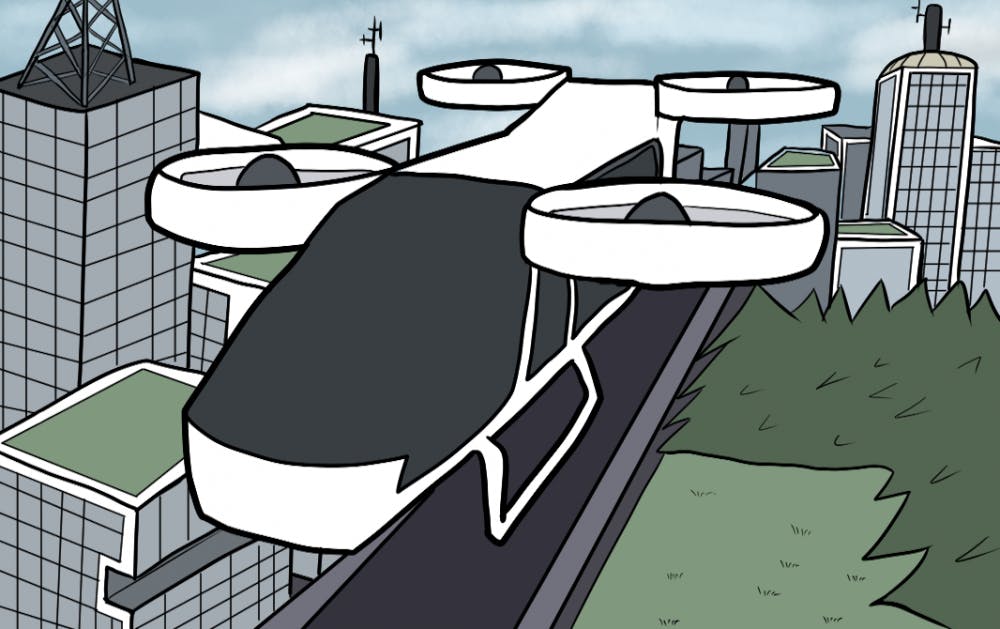The Weasley family's flying Ford, The Jetsons' Hovercar and Doc's DeLorean time machine all have something in common: They’re fictional flying vehicles.
But soon, thanks to ASU’s BLISS Lab, the dream of hopping into one of these futuristic vehicles might not be all that unrealistic.
ASU students and faculty are working on developing a navigation and positioning system for European aeronautical company Airbus, one business out of dozens that is trying to make the flying vehicles, beyond traditional planes and helicopters, come to life.
Daniel Bliss, an associate professor in the school of electrical, computer and energy engineering and director of the BLISS Lab, has been working on a program with Airbus for a little over a year. He has been researching the technologies in the lab for the past 20 years and has published over 100 technical articles and conference papers.
Bliss said that the positioning system they are working on in the lab relies on radio frequency signals. The system can be used for autonomous vehicles of all different sizes.
“The thing about RF (radio frequency) is that it's very competitive, everybody wants to use the RF spectrum,” Bliss said. “Your cell phone carrier, the T.V., the Wi-Fi, all these things have little pieces of the spectrum and so you want to use the smallest amount of bandwidth possible. So one of the big technical challenges is how do you get that very, very accurate positioning, something down to sort of centimeters, when we don't actually have as much bandwidth as we would like in order to do that.”
Hanguang Yu, a graduate student under Bliss, is working mainly on the hardware side and is helping to build the radio system.
“We're building this radio system, it's a sort of like an alternative to the GPS," Yu said. "So this radio system can provide some ridge estimation for the (vehicles) and also measure the distance between two (vehicles)."
Yu said that this radio system can also tell the flying direction of the vehicle because of the multiple antennas.
Yu said that they have to consider non-ideal cases, to figure out solutions to make sure these flying vehicles are efficient.
“We're trying to provide a more safe navigation system for the vehicles," Yu said. "This radio system is independent of the GPS, so it does not have to worry if the GPS signal is weak."
Graduate student Andrew Herschfelt, working under Bliss, is responsible for writing the code for simulation validation platforms for the technologies developed in the lab.
Herschfelt said the biggest challenge throughout this process has been the specifications of the system itself.
“We are trying to achieve a very high performance with much fewer resources than a traditional system,” Herschfelt said. “We're not developing any brand new technologies, we are primarily adapting existing technologies.”
Bliss said that a big technical challenge is to have the systems talk back and forth to each other. He said the accuracy must be better than a tenth of a nanosecond to get the percision that they want.
"The more you know about it, the more magical it actually seems, because we are pushing technology in all sorts of different ways," Bliss said. "No one has actually done something like this before."
Herschfelt said the technology the lab is developing is intended to provide accurate positioning information for autonomous air vehicles, but it's similar to autonomous ground vehicle systems as well.
“We're designing a co-operative – a positioning system – so it is similar to GPS," Herschfelt said. "GPS works by having a network of satellites that communicates to your GPS device on the ground ... Instead of having satellites, the nodes talk to each other, so you get relative positioning by communicating back and forth between two different devices."
Herschfelt said the actual computer system is about the size of a piece of paper and about two inches thick. He also said that the lab is expecting to fly a version of the system in December. At that point, the team is expecting to have made all of its final adjustments in order to begin real experimentation.
Bliss said that the systems developed in the lab could not only be applied to human-fit air vehicles, but also be used for smaller drones.
“People have been promising us air-cars for decades and decades and actually it seems like we're on the edge of that happening,” Bliss said, “But (the system) also could be for smaller drones, potentially delivering things from one spot to another.”
Bliss said an example of these drones could potentially help carry emergency medical care products. He believes that these smaller scaled drones aren't far from reality.
“We might move from these drones being something people play with ... to really being a useful technology that improves people's lives in case of emergencies,” Bliss said, “Or you know, maybe improves people's lives in the sense that they're going to fly from one spot in a city to another spot in a city without having to drive through an hour of traffic.”
Reach the reporter at jlmyer10@asu.edu or follow @jessiemy94 on Twitter.
Like The State Press on Facebook and follow @statepress on Twitter.




